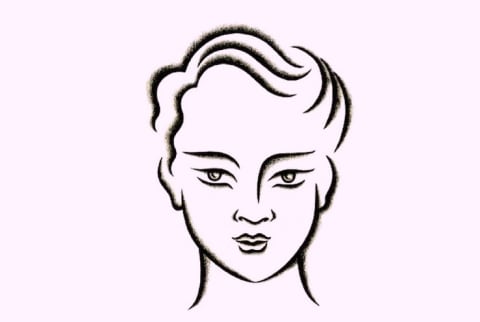Advertisement

Our skin is constantly communicating with us, but we don't always know what it's trying to say. According to Ayurveda, our external body is a reflection of our internal organs and can help us understand the state of our total health.
A key tool in practicing a lifestyle that best suits our body's needs is the dosha, a combination of energies that are responsible for your unique mental and physical characteristics. They are called Vata, Pitta, and Kapha.
These different energies, or doshas, exist within each person in varying proportions. The doshas also play another important role in our physical bodies, acting like captains that control different internal functions. Facial mapping can point to the captain that's out of balance internally, alerting us when certain areas need more attention and support.
Here are the four main parts of the face, what dosha each is governed by, and how to maintain balance both internally and externally through Ayurveda, which helps us understand the language of the skin, an explicit communication just waiting to be heard.
1. The Forehead
One of the areas on our face that represents Vata is the forehead, as it manifests Vata’s energies of space and air through its thin, cool, dry consistency. This skin has the least moisture, heat, and fatty tissue compared to the rest of the face.
When Vata is out of balance, you may see excessive dryness, expression and dehydration lines on the forehead, all of which can be caused by poor nutrition, lack of sleep, and stress.
To remedy imbalances such as dryness on the forehead, it’s important to choose skin care that deeply nourishes and hydrates the skin in addition to incorporating Vata nutritional guidelines into your diet.
- Eat: Warm, nourishing foods and drink plenty of water
- Move: Low-impact, grounding exercises such as yoga and Pilates will help maintain equilibrium.
- Do: Maintaining a regular sleep schedule (at least eight hours per night) and meditation upon waking and before sleeping is crucial to balancing Vata and healing your forehead.
2. The Cheeks
Ruled by the element of fire, the cheeks and nose are governed by Pitta, which is responsible for the level of inflammation in our bodies. Pitta speaks to us about the function of our liver, heat, and toxicity within the circulatory system.
When Pitta is out of balance, the cheeks can show inflamed, reddish blemishes, blackheads, broken capillaries, rashes, or may even exhibit rosacea.
Because these imbalances are related to the function of our liver as well as excess heat within the body, it’s important to purify the blood and cool the body internally.
- Eat: Avoid spicy foods, opting instead for calming, nourishing things like greens and watery fruits.
- Move: You'll also want to stay away from competitive sports and hot environments, so skip that Bikram yoga class and instead go for a swim or a long, scenic bike ride.
- Do: It's key to use gentle, soothing skin care products with antibacterial properties such as neem and sandalwood.
3. The Under-Eye Area
An external manifestation of the adrenals and kidneys, Vata imbalances are also visible through the under-eye area. When Vata isn't balanced, you'll see it in the form of dark circles and fine lines due to dehydration, and puffy eyes due to lymph stagnation and poor circulation.
- Eat: Drink ample water and hydrating teas and incorporate Vata-balancing foods such as nuts, cooked veggies, and low-fat dairy.
- Move: Soft, daily massages will encourage circulation and skin stimulation.
- Do: Use skin care that includes ghee, saffron, or amla to reduce dark circles, puffiness, and dehydration lines.
4. The Chin
The thicker tissue around the chin and jaw line represents the heavy, cool, moist elements of earth and water, or Kapha dosha. Internal hormones, yeast levels, and our reproductive system heavily influence this area of the face. If Kapha is out of balance, you may see excess oil, enlarged pores or cystic blemishes around the chin and mouth area.
- Eat: Imbalances in this area are often a result of excess fatty tissue, oils, and moisture within the body and can be remedied by reducing intake of heavy, fatty, fermented, and overly sweet foods.
- Move: Incorporate invigorating, high-stamina exercises like running or dance to metabolize excess fats and fluids in the body.
- Do: Stimulating, oil-balancing skin care with sage, rosemary, and mint can help reduce excess oil and blemishes that often arise on the chin.
Photo courtesy of the author
